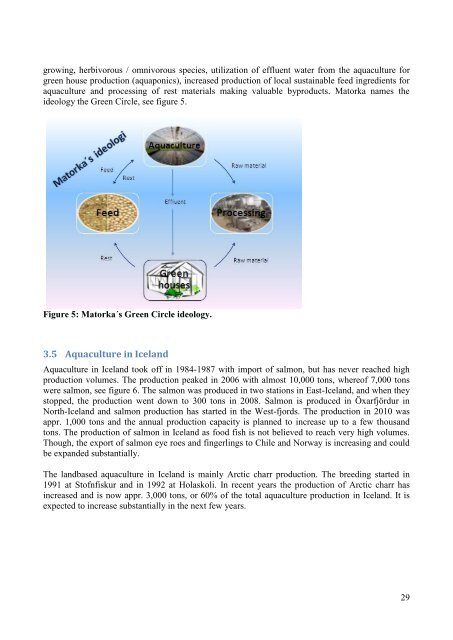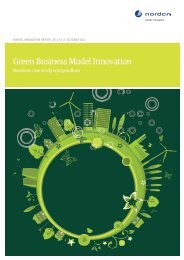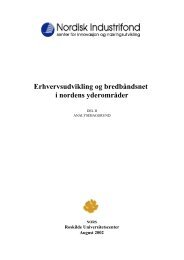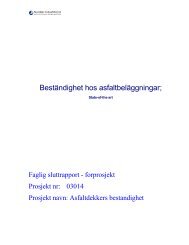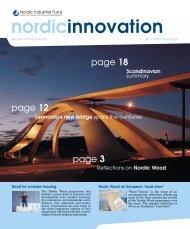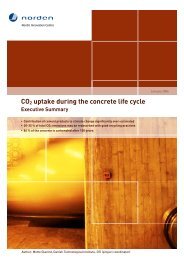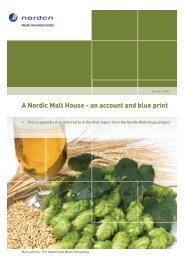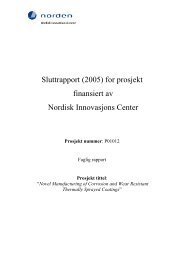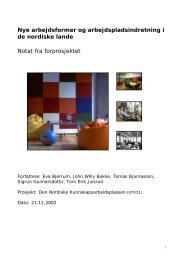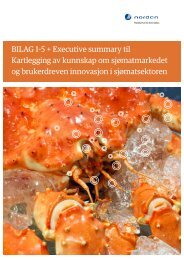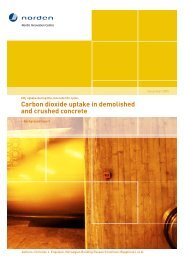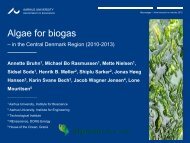Local raw materials for production of fish feed for ... - Nordic Innovation
Local raw materials for production of fish feed for ... - Nordic Innovation
Local raw materials for production of fish feed for ... - Nordic Innovation
You also want an ePaper? Increase the reach of your titles
YUMPU automatically turns print PDFs into web optimized ePapers that Google loves.
growing, herbivorous / omnivorous species, utilization <strong>of</strong> effluent water from the aquaculture <strong>for</strong><br />
green house <strong>production</strong> (aquaponics), increased <strong>production</strong> <strong>of</strong> local sustainable <strong>feed</strong> ingredients <strong>for</strong><br />
aquaculture and processing <strong>of</strong> rest <strong>materials</strong> making valuable byproducts. Matorka names the<br />
ideology the Green Circle, see figure 5.<br />
Figure 5: Matorka´s Green Circle ideology.<br />
3.5 Aquaculture in Iceland<br />
Aquaculture in Iceland took <strong>of</strong>f in 1984-1987 with import <strong>of</strong> salmon, but has never reached high<br />
<strong>production</strong> volumes. The <strong>production</strong> peaked in 2006 with almost 10,000 tons, where<strong>of</strong> 7,000 tons<br />
were salmon, see figure 6. The salmon was produced in two stations in East-Iceland, and when they<br />
stopped, the <strong>production</strong> went down to 300 tons in 2008. Salmon is produced in Öxarfjördur in<br />
North-Iceland and salmon <strong>production</strong> has started in the West-fjords. The <strong>production</strong> in 2010 was<br />
appr. 1,000 tons and the annual <strong>production</strong> capacity is planned to increase up to a few thousand<br />
tons. The <strong>production</strong> <strong>of</strong> salmon in Iceland as food <strong>fish</strong> is not believed to reach very high volumes.<br />
Though, the export <strong>of</strong> salmon eye roes and fingerlings to Chile and Norway is increasing and could<br />
be expanded substantially.<br />
The landbased aquaculture in Iceland is mainly Arctic charr <strong>production</strong>. The breeding started in<br />
1991 at St<strong>of</strong>nfiskur and in 1992 at Holaskoli. In recent years the <strong>production</strong> <strong>of</strong> Arctic charr has<br />
increased and is now appr. 3,000 tons, or 60% <strong>of</strong> the total aquaculture <strong>production</strong> in Iceland. It is<br />
expected to increase substantially in the next few years.<br />
29


